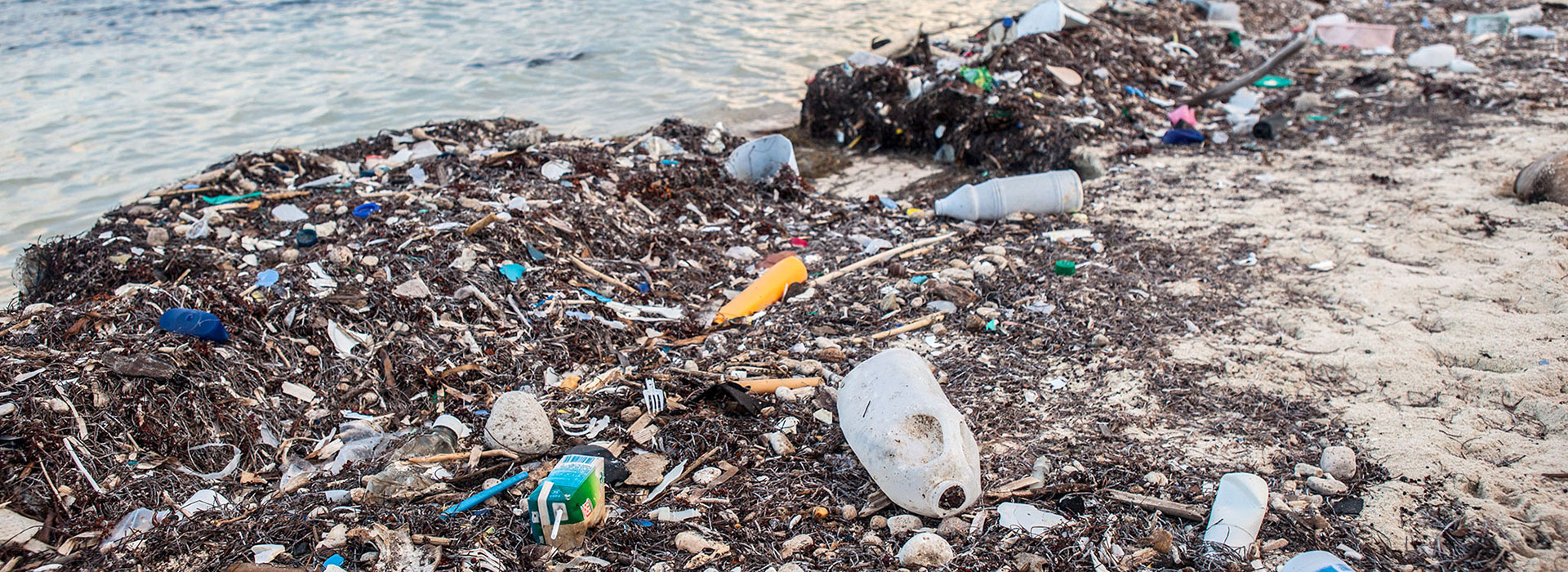Plastic: Not so fantastic
We at Locus believe no single-use plastic is worth the waste. And while we’re not totally against plastic, it’s time to say no to plastic misuse.
This report from Plastics Europe makes a case in favour of plastics. They report on the energy savings made by choosing plastic for packaging, as it is lighter weight than some alternatives. A study on plastic bags showed that the production uses fewer resources than creating a reusable cotton bag.
So it’s not all bad, right? Consider the full lifecycle of the plastic; seeing how much plastic ends up in the natural landscape, Plastics Europe has set a goal to keep all recyclable products and recoverable waste out of the landfill by 2025. Scotland has vowed to match this goal, and also to ban throwaway plastics by 2030. Companies around the world are working to find new ways to recycle more plastics and foam packaging, produce energy from plastic waste or use bioengineering to create a process that breaks down plastics for reutilisation elsewhere.
Whilst these objectives are to be commended, recycling the lot is a harder goal to reach in NZ. According to recycle.co.nz, a website sponsored by the Sustainable Business Network, “Not all plastics are recycled. Some types (1,2 and 4) are easier to recycle than others. Some get contaminated with food waste and cost more to be recycled (takeaway food and drink containers). Some plastic types (3,5,6 and 7) are simply not worth recycling. There is low value in the recovered plastics because they are harder to recycle and/or manufacturers struggle to make any profit from them.”
A city like Tauranga currently has residents pay for recycling collection and only accepts numbers 1 & 2, so the obligation to recycle here isn’t great. According to the Guardian, only 14% of plastics in the UK are recycled. And, much of our plastic waste is simply too small to recycle — namely single-use items and packaging. Plastic straws are a major culprit in ocean litter — 500 million straws are used, and trashed, in the US every day. When was the last time you put your coffee lid in the recycling or checked the number on your kid’s yoghurt pot? No wonder 8 tons of plastic ends up in the ocean each year.
“Throwback to last weekendʻs cleanup where 20 of us removed another 1/2 ton of #plasticpollution in a matter of hours! ” — @wildhawaii
Did you know: Literally every single piece of plastic ever produced from petrochemical-derived plastic ever created still exists, in large or small bits, somewhere on the planet. Follow accounts like @wildhawaii (shown here) or @parley.tv on Instagram to see the amount of plastic rubbish washing up on beaches around the world.
Alternative culture
But what about bioplastics plastics, you say? While these alternatives are a step forward by being produced from renewable sources, their end of life treatment is, in many cases, no better than their petrochemical counterpart. Currently, these cannot be recycled and many biodegradable plastics still require industrial composting. It’s time we said no to plastic misuse; single-use, unnecessary plastic that often ends up in our ocean, in the mouths of fish or washed up on previously pristine tropical beaches. And times, they are a-changing. McDonald’s has proposed an effort to use only recycled or renewable materials for food packaging and to provide better recycling facilities in their restaurants within 8 years. Amazingly, they’ve promised to ban styrofoam in all restaurants this year. Duncan Donuts has also promised to go foam-free for their coffee cups, and even the Queen has begun to ban plastics from her Royal estates. And while I hope this will lead to a global trend for general waste reduction, there is still more to be done. Until every bit of plastic can be recycled or made to break down completely and without toxins, until every bit of plastic is cleared from our oceans, we still have a long way to go. The good news is, there are a lot of ways for each of us to fight the supply and demand problem that is driving so much plastic waste, to begin with. Without demand for plastic, the supply at a corporate level will decrease. We predict within the next 10 years, making or buying things made with short life plastics will be as uncool as smoking is today. Smart companies will be ahead of this trend and making plans to change now. Common culture that starts at home can become a trend that spreads like wildfire. By reducing your own use of plastic, you could have an influence on your friends and neighbours to do the same. For example, school kids in Pillans Point, Tauranga, petitioned Fonterra to stop attaching plastic straws and wrappers to the cartons in their Milk for Schools programme. Such a small change at one end of the system can make a big impact on the litter that school kids see on their school fields.
“54 gross toothbrushes I found in 5 hours last week on the beach…”
— @nurdleintherough
Another ocean-plastic collector, Kat from Nurdle in the Rough regularly collects washed-up junk and polishes it into stunning jewels to embed in silver jewellery. I’m a big fan. Check out her work on Instagram: @nurdleintherough
Make the change
The plastic-free habit (or at least a less-plastic trend) is easy to get on board. It is surprisingly easy to make some simple changes in your plastic use habit. Here are some ideas that won’t break the bank — and may even save you some coin!
- Takeaway coffee
Each of us at Locus was gifted a Keep Cup and you can already see the evidence in our rubbish bins. Personalized colours give us ownership over our cups and we’ve already heard some heckling when someone forgets to use theirs. - Drink bottles
I’ve recently purchased a double-walled, stainless steel water bottle and I don’t think I’ll ever look back. It’s a good size to hold, keeps my ice water cold for hours, and fits in my laptop bag without spilling or getting crushed. I always thought the idea of paying for a single bottle of water was a bit ridiculous, to be honest. - Takeaways
Take your own Tupperware (you know, that pile of multi-use plastic containers in your pantry), use your own utensils or come home without those flimsy plastic ones, and carry a stainless steel straw. Encourage your local to switch from styrofoam or plastic containers to a more easily degradable material. Remember, even McDonald’s is jumping on the bandwagon to better their packaging. Also encouraging are events like Papamoa’s Dinner in the Domain and the Mount’s Little Big Markets, where the majority of vendors sell their food in paper-based packaging with bamboo utensils. - In the shower
This one might take some getting used to, but I’ve recently switched from bottled to Ethique’s concentrated bar shampoo, saving least 3 plastic bottles per bar. It didn’t take long to acclimate and the habit isn’t much different from using liquid shampoo. I’ve also switched from liquid body wash to back to good old bar soap. It lathers on my poof the same as a body wash, cleans the same, and my EcoStore soap comes in recyclable card packaging — watch out for other brands that still wrap in plastic. (My next experiment is to see how well each of these packages break down in my worm farm — stay tuned).
I have also gotten a lot of use out of my Inverse Hair Conditioning System — so much that I’ve stopped using mousse and leave-in conditioner. I love what it’s done for my traditionally frizzy, curly hair and I’m not ashamed to convince all my friends to try it. It’s not a hard sell once they try it. - Toothbrushes
A little beyond single-use, but a common item to find washed up on Pacific Island beaches, is the lowly toothbrush (example above). I can recommend the bamboo toothbrushes made and delivered to your house in paper-only packaging by Toothcrush. A subscription service means you pay once for brushes all year and seeing as I don’t go through them quickly, I’ve got a nice back-stock built up. They even make one sized for the tiny humans in your life! The plan I’m on works out to just over $3 a brush, comparable to the average supermarket toothbrush.
Don’t stop there!
Here are a couple of problems that I am calling on smart companies to solve:
- Freezer bags for veges and berries, bagged lettuce, and plastic wrapped veges. Sure plastic can extend the life of some foods, and that’s great, but there must be something better. On that note, I’ve just read about a South Island New World, reducing plastic and making their produce shelves prettier at the same time.
- Toothpaste packaging. I’ve seen some toothpaste alternatives (solid bars or powders) but they’re still packaged in plastic. Ugh.
- Cleaning products. Again, there must be a better way to get liquids from the store to my floor without utilising plastic.
- Anything else? What other single-use plastics have you seen without an alternative? Let us know in the comments below.
How long do you think it will take for the world to kick our single-use plastic habit and make it simply uncool to use and immediately dispose of silly misused plastics?
Feature image c/o National Geographic
Want to read more on creativity, design, product development and innovation? Go to our Six Lenses Blog.


Comments